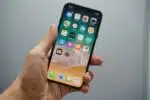
Apple announced Clean Energy Charging with iOS 16 and introduced it in the United States in 2022. Many users have stated worry if this reduces the efficiency or speed of charging their Apple devices, otherwise impacting their electronics and power consumption.
If you’re interested in learning more about renewable energy or are delving into switching to renewable energy more in your home and reducing your overall carbon footprint, in this post, we’ll explain what Clean Energy Charging is, its potential impacts on the overall power grid, and how using renewable energy, whether personally at home or by larger companies incorporating new ideas that can make changes for the better.
What is Clean Energy Charging?
Clean Energy Charging is Apple’s attempt at bringing awareness to using cleaner energy and helping users make climate-smart choices. Clean Energy Charging selectively charges your Apple device when lower-emission electricity such as wind or solar is readily available. Depending on your region this could be daytime or at night. You can opt-out if you would rather not use it.
To support their feature, your iPhone gets a forecast of carbon emissions on your local energy grid, it then charges your phone when the cleanest energy is available.
How does Clean Energy Charging Work?
Clean Energy Charging works by selectively charging your device when lower carbon-emission electricity is available. It utilizes local carbon emissions data to reduce its overall carbon footprint.
Clean Energy Charging only charges your device when your house is pulling from cleaner sources of energy based on your local electrical grid, for some areas this may be during the daytime when renewable energy, such as solar power, is at its peak, though most will be during nighttime. Your iPhone will get a forecast of the carbon emissions on your local power grid, and charges when the cleanest power is available.
When you plug your phone in to charge, it will do so. With Clean Energy Charging enabled it may decide to suspend charging until the cleanest energy is available. A lock screen notification will let you know when it does so and how long it estimates it will take for your device to fully charge up. You can also touch and hold the notification itself, tap Charge Now, and receive a proper charge if you’re in a hurry.
It can all also be opted out of if you prefer.
- Clean Energy Charging is (so far) only available in the United States where it is enabled on your iPhone after updating to iOS 16.1
- It tends to work best with Optimized Battery Charging enabled, as it learns your charging habits to the extent that cleaner energy activates closest to when you tend to charge your phone. Which could be at bedtime or in the middle of the day.
- You need to have your Location services settings set to work with it so that it can reach your local grid and patterns.
- You can easily toggle it off under Settings – Battery – Battery Health & Charging, and there will be a toggle for Clean Energy Charging.
- It is smart enough to see if you’re travelling, in a new location, or at times where you may be away from reception; when it detects any of those it will automatically turn itself off.
Why has Apple released Clean Energy Charging?
Apple decided to release Clean Energy Charging to better help users make climate-smart choices and to better work with renewable energy and bring it to consumers’ attention.
Can Clean Energy Charging and other similar actions affect the electricity grid and renewable energy consumption?
Although phone charging is not the most energy-consuming activity, there are billions of iOS devices across the world, which has a big impact on global energy consumption. Such a change could make more consumers interested in learning about green energy, passive housing, bi-directional meters, and even transitioning to 100% renewable sources. However, it is not possible at this point to estimate if and how that will affect energy grids in the long run.
Similar projects:
For those interested in learning about which apps to use that are similar in nature that work best with solar panels you may already have, or are interested in looking into, to get a gauge on what information is most important:
- EMA App – The EMA App is a mobile energy monitoring app designed for use by owners of APS microinverter products. You can check the real-time performance, environmental benefits of your PV systems, and power output history. You can see a representation of your solar panels individually and determine how well each is performing. You can also track the output of your system daily, weekly, monthly, yearly, and lifetime.
Another feature is that it helps calculate energy savings and environmental savings, broken down into terms such as gasoline, trees, and CO2 emissions.

- MySolarEdge Monitoring App – The SolarEdge monitoring app is another popular one when it comes to tracking your solar system’s energy production and overall output. It can be easily accessed from any internet-enabled devices such as computers, phones, or tablets. It includes analysis and robust reporting tools that even allow users to schedule automatic reports and can set alerts on any system issues. MySolarEdge can also help customers detect excessive energy use, allowing you to get ahead on potentially expensive electric bills.

- Enphase – Enphase’s main solar monitoring app is based in-browser on the web, with a desktop or laptop. They recently launched a mobile app which includes most of the same actions you can do on a desktop. While not all the actions are present, users can at-a-glance monitor their solar system and see how much energy there is being used and stored, with a real-time, in-depth view of your solar systems.












